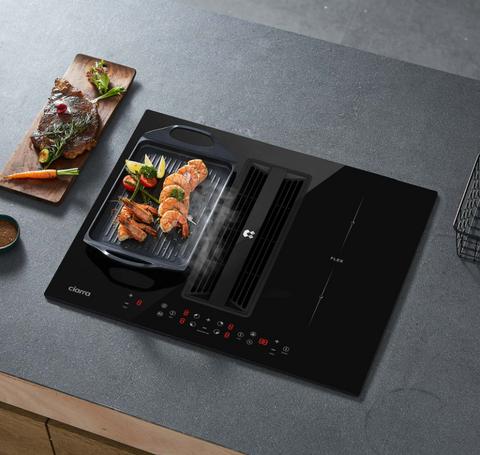The popularity of venting hobs is unquestionably on the rise. Since my initial encounter with them several years ago, the inclusion of venting hobs in kitchen projects has significantly increased.
Nevertheless, using a venting hob may still be perplexing, creating a sense of mystery regarding its functionality and integration into the kitchen design and installation.
This article addresses the technical queries about venting hob installation and operation while maintaining a clear and informative approach.

Understanding Vented Hobs:
Before delving into technical details, it's crucial to recall that a vented hob, also known as a downdraft cooktop, hob with a built-in extractor, or an extractor hob, is a cooking appliance that incorporates an efficient ventilation system within its structure. It combines a hob and a cooker hood into a single appliance.
The primary purpose of a vented hob is to eliminate the necessity for a separate overhead extraction hood by integrating the extraction fan directly into the hob. When cooking commences, the vented hob efficiently draws in steam, smoke, and odors directly from the pots and pans.
While venting hobs are commonly induction-based, they are also available as ceramic (electric) and gas models.
Mechanism of Venting Hobs:
The hob utilizes gas or electricity (induction or ceramic) during operation to heat the cookware. Simultaneously, the integrated extractor fan activates to draw in resulting steam, smoke, and odors.
In a ducted vented hob, the extracted air is directed through installed ductwork, venting it outside the building and maintaining a clean kitchen environment. Alternatively, a vented hob with a recirculation mode routes the drawn air through internal filters, trapping grease and neutralizing odors before releasing it back into the kitchen.
Space Requirements for Venting Hobs:
Typically, venting hobs require between 200 – 300mm depth from the top of the countertop into the cabinet underneath. The space occupied is usually equivalent to the top drawer's size, extending possibly into the middle drawer, depending on the model.
The width space required varies with the cooktop's size, ranging between 60 – 90cm. However, the exact width may differ among makes and models, and the cooking surface is often slightly wider than the housing underneath.
Apart from the main body of the venting hob, considerations also need to be made for the positioning of venting ductwork.
Installation of Ductwork for Vented Hobs:
Ducting extends from the hob, running into the plinth space beneath the kitchen cabinet. Some manufacturers and models allow the ducting to be rotated for different exit points (left, right, or back).
The ducting can either vent externally by going to an outside wall or recirculate into the room through a grill or opening in the plinth/toe kick.
The installation may require additional space behind the kitchen cabinet, typically 70cm deep if the ducting comes from the back of the hob and down. This depth can often be accommodated between cabinets or end panels for kitchen islands. However, in cabinets against a wall, adjustments might be needed.
In some instances, the ducting might come down inside the kitchen cabinet, requiring adjustments to accommodate shallow-depth drawers or modifying the drawer box to work around the ducting.
Ultimately, the impact on drawer space and depth depends on the specific make, model, ducting positioning, and the kitchen layout's location.
Conclusion:
As venting hobs gain popularity, this guide offers a clear roadmap to understand their dual functionality, spatial requirements, and installation intricacies. It provides valuable insights, from eliminating the need for separate extraction hoods to optimizing cabinet space. Whether induction, ceramic, or gas, venting hobs redefine the kitchen experience, seamlessly blending technology and aesthetics. As you embrace the trend, use this guide to navigate the world of vented hobs confidently.

